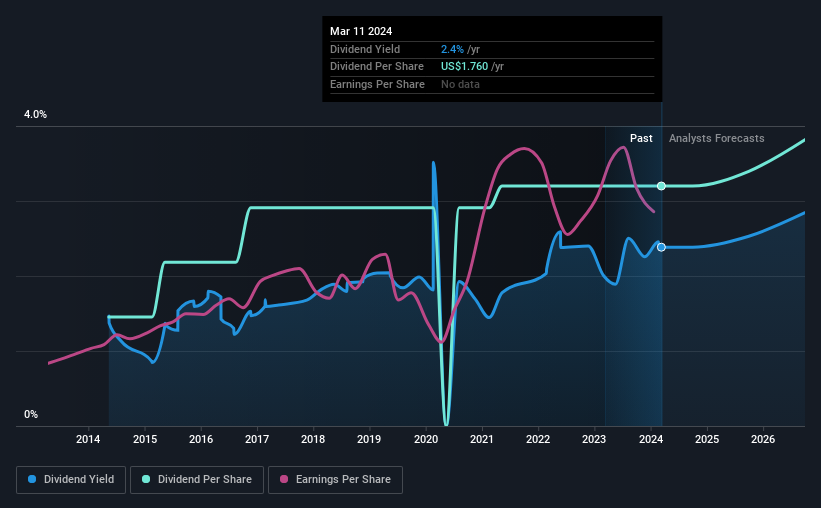- United States
- /
- Hospitality
- /
- NasdaqGS:JACK
Jack in the Box (NASDAQ:JACK) Has Affirmed Its Dividend Of $0.44
The board of Jack in the Box Inc. (NASDAQ:JACK) has announced that it will pay a dividend on the 27th of March, with investors receiving $0.44 per share. This means that the annual payment will be 2.4% of the current stock price, which is in line with the average for the industry.
View our latest analysis for Jack in the Box
Jack in the Box's Earnings Easily Cover The Distributions
We like a dividend to be consistent over the long term, so checking whether it is sustainable is important. However, prior to this announcement, Jack in the Box was quite comfortably covering its dividend with earnings and it was paying more than 75% of its free cash flow to shareholders. The business is earning enough to make the dividend feasible, but the cash payout ratio of 86% shows that most of the cash is going back to the shareholders, which could constrain growth prospects going forward.
The next year is set to see EPS grow by 56.0%. If the dividend continues on this path, the payout ratio could be 20% by next year, which we think can be pretty sustainable going forward.

Dividend Volatility
The company's dividend history has been marked by instability, with at least one cut in the last 10 years. Since 2014, the dividend has gone from $0.80 total annually to $1.76. This implies that the company grew its distributions at a yearly rate of about 8.2% over that duration. A reasonable rate of dividend growth is good to see, but we're wary that the dividend history is not as solid as we'd like, having been cut at least once.
We Could See Jack in the Box's Dividend Growing
With a relatively unstable dividend, it's even more important to evaluate if earnings per share is growing, which could point to a growing dividend in the future. Jack in the Box has seen EPS rising for the last five years, at 6.0% per annum. Growth in EPS bodes well for the dividend, as does the low payout ratio that the company is currently reporting.
Our Thoughts On Jack in the Box's Dividend
In summary, while it's good to see that the dividend hasn't been cut, we are a bit cautious about Jack in the Box's payments, as there could be some issues with sustaining them into the future. The company hasn't been paying a very consistent dividend over time, despite only paying out a small portion of earnings. We would probably look elsewhere for an income investment.
Investors generally tend to favour companies with a consistent, stable dividend policy as opposed to those operating an irregular one. However, there are other things to consider for investors when analysing stock performance. To that end, Jack in the Box has 3 warning signs (and 1 which makes us a bit uncomfortable) we think you should know about. Looking for more high-yielding dividend ideas? Try our collection of strong dividend payers.
New: Manage All Your Stock Portfolios in One Place
We've created the ultimate portfolio companion for stock investors, and it's free.
• Connect an unlimited number of Portfolios and see your total in one currency
• Be alerted to new Warning Signs or Risks via email or mobile
• Track the Fair Value of your stocks
Have feedback on this article? Concerned about the content? Get in touch with us directly. Alternatively, email editorial-team (at) simplywallst.com.
This article by Simply Wall St is general in nature. We provide commentary based on historical data and analyst forecasts only using an unbiased methodology and our articles are not intended to be financial advice. It does not constitute a recommendation to buy or sell any stock, and does not take account of your objectives, or your financial situation. We aim to bring you long-term focused analysis driven by fundamental data. Note that our analysis may not factor in the latest price-sensitive company announcements or qualitative material. Simply Wall St has no position in any stocks mentioned.
About NasdaqGS:JACK
Jack in the Box
Develops, operates, and franchises quick-service restaurants (QSR) in the United States.
Undervalued with moderate growth potential.
Similar Companies
Market Insights
Community Narratives



